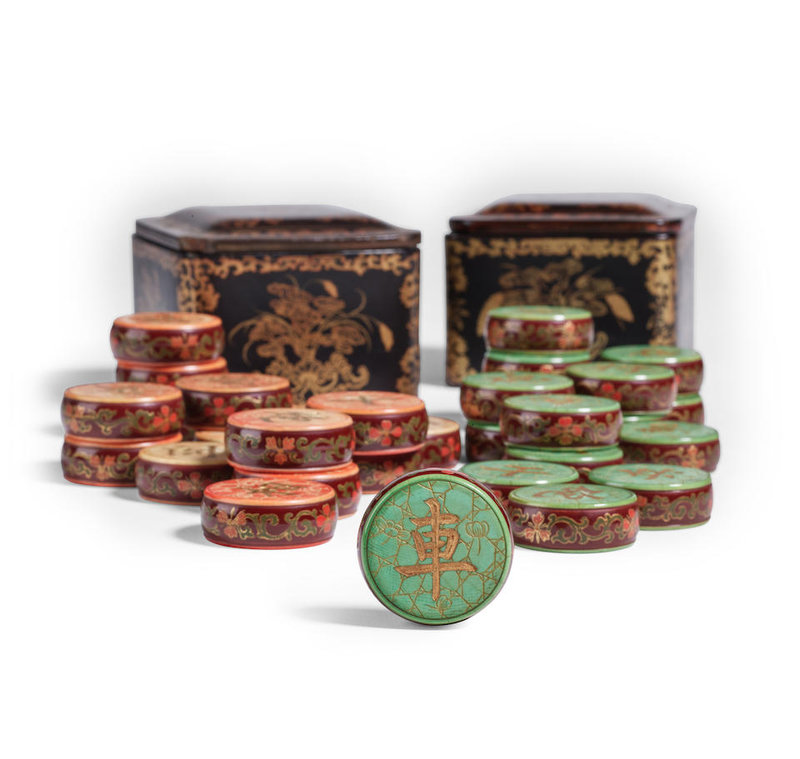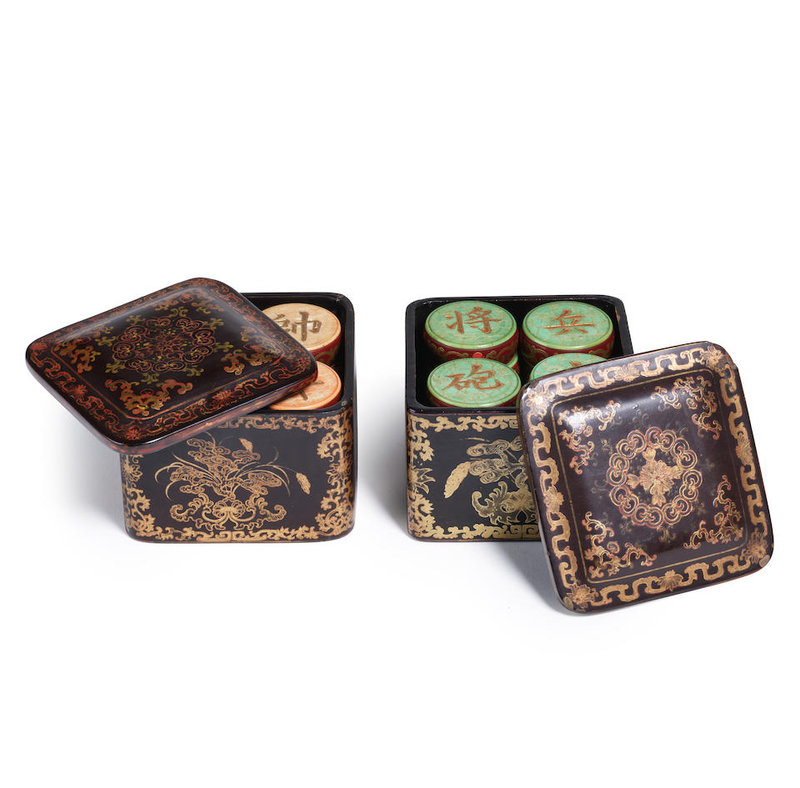A set of Imperial stained ivory 'xiangqi' pieces with two painted lacquer boxes and covers, Yongzheng period (1723-1735)
Lot 63. A set of Imperial stained ivory 'xiangqi' pieces with two painted lacquer boxes and covers, Yongzheng period (1723-1735). Boxes 8.2cm (3.5in) wide each; xiangqi piece 3.2cm (1 1/4in) diam each. Estimate HK$ 1,500,000 - 2,000,000 (€ 170,000 - 230,000). © Bonhams 2001-2021
This pair composed of thirty-two circular xiangqi pieces incised with characters infilled with gilt against a ground of prunus blossoms on the top, sixteen pieces stained in red and incised with a crane roundel clasping a lingzhi fungus in its beak on the reserve, the other sixteen pieces stained in green and incised with a descending bat, the fitted square boxes and covers exquisitely painted on each side in gilt with clusters of lingzhi fungus within a border of leafy lotus scrolls on black lacquer.
Provenance: A French private collection, acquired in the first half of the 20th century
Christie's London, 9th November 2010, lot 206.
Note: Xiangqi or Chinese chess was mentioned in historical texts dated to 1st century BC, Shuoyuan, that the Lord Mengchang of Qi(died 279 BC) was a renowned player of xiangqi, which suggests its emergence was probably even earlier than the Spring and Autumn period. The character xiang, previously misunderstood as 'elephants', refers to 'astronomy', thus the movement of the pieces representing the apparent movements of the naked-eye-visible astronomical objects in the night sky; see related discussion by H.J.R.Murray, A History of Chess, New York, 2012, p.122.
Xiangqi was popular among all the classes, probably because of its simpler rules and less time-consuming than weiqi. Modern xiangqi has been forming in the Song Dynasty when scholars started to compose weiqi records which can be found in the Shilin guangji (Vast Records of the Matters Forest) by Chen Yuanliang (active in the 13th century).
The gilt-lacquer box has a strong influence from Japan, which was particularly popular during the Yongzheng period. Compare the gilt-painted flower scrolls with those on related gilt-lacquered bowl in the Palace Museum, Beijing, Yongzheng, which is illustrated in the The Complete Collection of Treasures of the Palace Museum: Lacquer Ware of the Qing Dynasty, Hong Kong, 2006, pl.102. Compare also with another box and cover with similar gilt-lacquered decoration, which is illustrated in Collections of the Palace Museum, Beijing, 1974, pl.171. Similar flower scrolls on the box and xiangqi pieces can be widely found on other works of art in the Yongzheng period, compare the flower scrolls with a painted-enamel gilt-copper vase with a six-neck body and winding lotus motif in the Palace Museum, Beijing, which is illustrated in Harmony and Integrity: The Yongzheng Emperor and His Times, Taipei, 2009, p.250.
Ivory xiangqi pieces rarely survived; compare however, with a set of jade xiangqi pieces in the National Palace Museum, Taipei, which is illustrated in Wenfang juying, Taipei, 1993, no.171.
Bonhams. Elegant Gatherings.The Social Art of Chinese Scholars, Hong Kong, 2 Dec 2021

/https%3A%2F%2Fprofilepics.canalblog.com%2Fprofilepics%2F1%2F0%2F100183.jpg)
/https%3A%2F%2Fstorage.canalblog.com%2F03%2F02%2F119589%2F96711876_o.jpg)
/https%3A%2F%2Fstorage.canalblog.com%2F11%2F31%2F119589%2F94773502_o.jpg)
/https%3A%2F%2Fstorage.canalblog.com%2F20%2F83%2F119589%2F94772815_o.jpg)
/https%3A%2F%2Fstorage.canalblog.com%2F26%2F72%2F119589%2F75604929_o.jpg)
/https%3A%2F%2Fstorage.canalblog.com%2F59%2F60%2F119589%2F26458628_o.jpg)








/image%2F1371349%2F20240423%2Fob_b2fe42_telechargement-9.jpg)
/image%2F1371349%2F20240423%2Fob_af8bb4_telechargement-6.jpg)
/image%2F1371349%2F20240423%2Fob_b6c4a6_telechargement.jpg)
/image%2F1371349%2F20240423%2Fob_981d5f_h22891-l367411650-original.jpg)